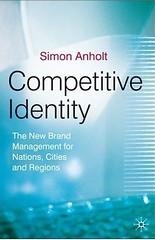Following the follower of the followers: historic preservation
Luke Johnson, a private equity investor and the chairman of the UK's Channel 4, writes a column on entrepreneurship that runs weekly, in the Wednesday issue of the Financial Times. In his most current column, "Hard talk behind the boardroom door" he has a great quote:
There is nothing a country's citizens cannot achieve with the right leadership, incentives and culture.
Of course, this is true for governments and institutions and corporations of all shapes and sizes.
And is why, for the most part, that I find living in DC and the political and governance structure of both the local and national governments, to be, so often, disappointing.
This comes up because the word is out that Mayor Fenty has ordered the DC Historic Preservation Office to be mindful of this edict: "No more historic districts."
Likely this isn't because the Mayor is jumping the tune called by developers, but because the process of creating a historic district is messy and obstreperous and full of conflict. And like most elected and appointed officials, the Mayor doesn't like conflict. He likes to be in control.
But at the same time, leaders lead and are supposed to help the governed make the hard and right choices to build stronger, better and more equitable communities. Mayor Joseph Riley of Charleston, one of the most eloquent public officials in the country about quality of place and how historic preservation contributes to it, is a leader. I don't think that Mayor Fenty is a leader in the same way. He's in charge sure, but is he a leader, is he focused on transformation, or is he merely in charge (you know the Who song with the line "meet the new boss, same as the old boss" don't you?).
It is pretty clear that Mayor Fenty doesn't understand what the city's competitive advantages are, in terms of the quality of life and economic competitiveness of the local city for the most part, but not completely, independent of the national government:
1. historic architecture;
2. urban design dating from the Walking and Transit City eras;
3. history, identity and authenticity (see e.g., Competitive Identity: The New Brand Management for Nations, Cities and Regions by Simon Anholt);
4. a rich transit infrastructure that enables time and cost efficient mobility independent of the privately owned automobile; and
5. the steady employment and economic engine of the federal government.
______________
This is something that I have been writing in the planning studies that I do in other communities:
Community branding is an important issue that all municipalities must address. At its root, it is about identity and vision and being focused at all times on achieving the vision that the community intends to achieve and maintain. Everything about [your community] either supports or diminishes how the city is perceived throughout the region and beyond.
A destination’s identity (brand) is the sum of what people think when they hear the community (brand) name. It's how prospects feel when they first arrive at the destination's website or experience other communication, and it's what people expect to experience once they arrive to a place after having selected it over other choices.
There are well-branded cities and places...with well-defined stories (narratives and themes), distinct attributes, consistent messaging, and delivery of the brand promise at all touch points but less well-branded communities believe the brand is a logo ... and they aren’t focused on making the experience deliver on all dimensions within their destination.
Successful destination branding requires:
1) Clear definition of the place and what it offers;
2) Being distinct;
3) Delivering on the definition and the promise;
4) Consistently communicating the definition in all forms.
Just as the study team believes that “we are all destination managers now,” elected and appointed officials in particular and in association with other community stakeholders serve as a community’s “brand managers”—whether or not they choose to think of their roles in this manner.
That means that decision-making on land use and zoning, business issues, infrastructure development (roads, sewers, water, utilities, transit), technology (broadband Internet, etc.) and quality of place factors (arts, culture, historic preservation and heritage, schools, etc.) must be consistent and focused on making the right decisions, the decisions that achieve and support the realization of the community’s desired vision and positioning.
_______________
In DC, elected and appointed officials, active citizens, civic associations, major institutions, and other stakeholders are stewards of the city's identity and "brand" and need to be far more responsible than they have been thus far when making decisions that either support, or too often, diminish those qualities that stabilize, maintain, and extend the city's livability.

Labels: civic engagement, electoral politics and influence, historic preservation, progressive urban political agenda



0 Comments:
Post a Comment
<< Home